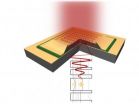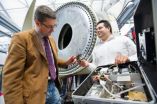(Press-News.org) Scientists have for the first time witnessed the mechanism behind explosive energy releases in the Sun's atmosphere, confirming new theories about how solar flares are created.
New footage put together by an international team led by University of Cambridge researchers shows how entangled magnetic field lines looping from the Sun's surface slip around each other and lead to an eruption 35 times the size of the Earth and an explosive release of magnetic energy into space.
The discoveries of a gigantic energy build-up bring us a step closer to predicting when and where large flares will occur, which is crucial in protecting the Earth from potentially devastating space weather. The study is published in The Astrophysical Journal.
While solar flares have long been a spectacular reminder of our star's power, they are also associated with Coronal Mass Ejections (CMEs) – eruptions of solar material with a twisted magnetic structure flying out of the Sun and into interplanetary space.
Space weather such as CMEs has been identified as a significant risk to the country's infrastructure by the UK's National Risk Register. Late last year The UK's MET Office announced it would set up a daily space weather forecast to work with the USA's Space Weather Prediction Center (SWPC).
The paper's lead author, Dr Jaroslav Dudik, Royal Society Newton International Fellow at the University of Cambridge's Centre for Mathematical Sciences, said: "We care about this as during flares we can have CMEs and sometimes they are sent in our direction. Human civilisation is nowadays maintained by technology and that technology is vulnerable to space weather. Indeed, CMEs can damage satellites and therefore have an enormous financial cost."
"They can also threaten airlines by disturbing the Earth's magnetic field. Very large flares can even create currents within electricity grids and knock out energy supplies."
One such event hit the Earth before technology was as integrated into human civilization as it is now, but still had a marked effect. In 1859 the Carrington storm made night skies so bright that newspapers could be read as easily as in daylight and telegraph systems caught fire.
Knowing the standard scientific models are right is therefore very important. The standard 3D model of solar flares has shown that they occur in places where the magnetic field is highly distorted.
In these places, the magnetic field lines can continuously reconnect while slipping and flipping around each other. In doing so, new magnetic structures are created.
Long before the flare the magnetic field lines are un-entangled and they appear in a smooth arc between two points on the photosphere (the Sun's visible surface) – areas called field line footpoints.
In a smooth, none-entangled arc the magnetic energy levels are low but entanglement will occur naturally as the footpoints move about each other. Their movement is caused as they are jostled from below by powerful convection currents rising and falling beneath the photosphere.
As the movement continues the entanglement of field lines causes magnetic energy to build up.
Like a group of straight cords which has been twisted, the lines will hold the energy until it becomes too great and then will release it, "straightening" back to the lower energy state.
Co-author Dr Helen Mason, Head of the Atomic Astro-Physics Group at the University of Cambridge, said: "You build the stress slowly until a point where they are no longer sustainable. The field lines say they have had enough and 'ping', they go back to something simple."
That "ping" creates the solar flare and CME. The word "ping" belies its power of course. Temperatures in the hotspots of the ejection can reach almost 20 million Degrees Celsius.
The theory remained unconfirmed until Dudik was reviewing footage of the Sun for an unrelated project last year.
It is no surprise it has taken so long to make the discovery. The technology that created the video is part of the Solar Dynamics Observatory (SDO) satellite mission which was only launched in 2010 by NASA.
It watches the Sun in the ultra-violet with the Atmospheric Imaging Assembly (AIA) capturing ultra-high-definition images every 12 seconds.
The final piece of the theoretical jigsaw was put in place in 2012 by French scientists – a paper published just six days before the flare occurred. Dudik admits that the serendipity the discovery is hard to ignore. But in science, fortune favours the prepared: "Suddenly I knew what I was looking at," he said.
What Dudik witnessed was the ultra-violet dance caused by the magnetic field lines slipping around each other, continuously "unzipping" and reconnecting as the footpoints of the flare loops move around on the surface. But during the flare, the footpoint slipping motion is highly ordered and much faster than the random motions entangling the field before the flare.
Dudik's observations were helped by the sheer size of the flare he was looking at – it could encompass 35 Earths. Not only that, the flare was of the most energetic kind, known as an X Class flare, and it took around an hour to reach its maximum.
If it had happened in a smaller flare, the slipping motion might not have been visible, even with NASA's technology to help.
Although only seen in an X Class flare to date, the mechanism might well be something which happens in all flares, said Dudik: "But we are not yet certain."
The importance of seeing the evidence of theory cannot be underestimated said Dr Mason: "In recent years there have been a lot of developments theoretically but unless you actually tie that down with observations you can speculate widely and move further away from the truth, not closer, without knowing it."
INFORMATION:
For additional information please contact:
Paul Holland, communications officerOffice of CommunicationsUniversity of Cambridge
Tel: +44 (0) 1223 332306
Email: paul.holland@admin.cam.ac.uk
Notes for editors:
The paper, Slipping Magnetic Reconnection During an X-Class Solar Flare Observed by SDO/AIA by J. Dudık, M. Janvier, G. Aulanier, G. Del Zanna, M. Karlicky, H. E. Mason, and B. Schmieder, is published in The Astrophysical Journal: http://iopscience.iop.org/0004-637X/784/2/144/.
To view video: http://www.youtube.com/watch?v=C6_vyJMSD2k&feature=youtu.be.
The SDO/AIA data are courtesy of the NASA/SDO and AIA science teams. For more information about the Solar Dynamics Observatory go to: http://sdo.gsfc.nasa.gov/.
First sightings of solar flare phenomena confirm 3D models of space weather
Video of magnetic field lines 'slipping reconnection' bring scientists a step closer to predicting when and where large flares will occur
2014-03-27
ELSE PRESS RELEASES FROM THIS DATE:
Military men more distressed by sexual harassment than military women, research finds
2014-03-27
WASHINGTON – Military men who are targets of frightening and threatening sexual harassment may experience more distress and work performance problems than military women who face the same treatment, according to research published by the American Psychological Association.
A total of 52 percent of military women said they had been sexually harassed compared with 19 percent of military men, and women more frequently reported they were very frightened by the experience than their male colleagues, according to a study published online in APA's Journal of Occupational Health ...
Gen X obesity a major problem for healthcare, workforce
2014-03-27
Researchers at the University of Adelaide have confirmed that if current trends continue, Australia's Generation X will overtake Baby Boomers for poor health, including rates of obesity and diabetes, which could have huge implications for healthcare and the workforce.
In a paper published in the online journal PLOS ONE, University of Adelaide researchers compared the health status of Baby Boomers (born from 1946–1965) and Generation X (1966–1980) at the same age range of 25-44 years.
They found Generation X had significantly poorer levels of self-rated health, and higher ...
Kaixin Jieyu Fang for treatment of vascular depression
2014-03-27
The Chinese compound Kaixin Jieyu Fang can be used to treat vascular depression; however, the underlying mechanism remains unclear. Dr. Ying Zhang and co-workers from Guang'anmen Hospital, China Academy of Chinese Medical Sciences in China This study established a rat model of chronic cerebral ischemia-caused white matter damage by ligation of the bilateral common carotid arteries. Rats received daily intragastric administration of a suspension of Kaixin Jieyu Fang powder. Kaixin Jieyu Fang was made from two prescriptions of Kaixin San and Sini San supplemented with Radix ...
Despatch from the field
2014-03-27
Researchers and the public can now have immediate access to data underlying discovery of new species of life on Earth, under a new streamlined system linking taxonomic research with open data publication.
The partnership paves the way for unlocking and preserving a wealth of 'small data' backing up research conclusions, which often become lost within a few years of an article's publication in an academic journal.
In the first example of the new collaboration in action, the Biodiversity Data Journal carries a peer-reviewed description of a new species of spider discovered ...
Acupuncture enhances antidepressant effect of Seroxat
2014-03-27
Acupuncture is more effective than oral antidepressants in improving depressive symptoms, and produces fewer side effects than tricyclic antidepressants. Despite the continued development of antidepressants and alternative/synergistic therapies, major depressive disorder has not been comprehensively recognized and treatment outcome is often insufficient. An epidemiological study addressing depression showed that poor recognition and treatment are largely linked to the lack of an accurate assessment tool and to patients' economic situation. Prof. Yong Huang and team from ...
Hormone levels linked to survival of deer calves, study suggests
2014-03-27
Levels of a key hormone in the blood may be important for the survival prospects of newborn animals, a study of wild deer suggests.
First-born male deer that have relatively high levels of the male hormone testosterone are less likely to survive their first year compared with their peers, the research shows.
Scientists say their findings suggest that high testosterone levels represent a risk to newborns which, when coupled with a new mother's inexperience, lowers their chances of survival.
High levels of testosterone in adult male animals, including deer, are known ...
Ultra-thin light detectors
2014-03-27
This news release is available in German. Subtle interactions of electrons and light make them so valuable for technology: ultra-thin systems of semiconductor layers can turn electrical voltage into light. But they can also be used the other way around and serve as light detectors. Until now, it has been hard to couple light into these layered semiconductor systems. Scientists at Vienna University of Technology solved this problem. They used metamaterials, which are able to manipulate light in the terahertz range due to their special microscopic structure.
Customized ...
Simple blood test may predict if a child will become obese
2014-03-27
Researchers at the Universities of Southampton, Plymouth and Exeter used the test to assess the levels of epigenetic switches in the PGC1a gene – a gene that regulates fat storage in the body.
Epigenetic switches take place through a chemical change called DNA methylation, which controls how genes work and is set during early life.
The Southampton team found that the test, when carried out on children at five years old, differentiates between children with a high body fat and those with a low body fat when they were older. Results showed that a rise in DNA methylation ...
Predicting oil changes in industrial applications without interrupting operations
2014-03-27
This news release is available in German.
Predictive maintenance of hard-to-access plants, no unnecessary oil changes, no unnecessary laboratory costs and less environmental impact. These are just some of the benefits offered by a new system that can monitor the condition of lubricating oils, hydraulic oils and other fluids in industrial installations without interrupting ongoing operations. The method was developed by engineers from Saarbrücken in collaboration with project partners. The compact sensor system is available as a portable unit or can be built into ...
Democratizing data visualization
2014-03-27
In 2007, members of the Haystack Group in MIT's Computer Science and Artificial Intelligence Laboratory released a set of Web development tools called "Exhibit." Exhibit lets novices quickly put together interactive data visualizations, such as maps with sortable data embedded in them; sortable tables that automatically pull in updated data from other sites; and sortable displays of linked thumbnail images.
In April, at the Association for Computing Machinery's Conference on Human Factors in Computing Systems, Haystack members will present an in-depth study of the ways ...
LAST 30 PRESS RELEASES:
Numbers in our sights affect how we perceive space
SIMJ announces global collaborative book project in commemoration of its 75th anniversary
Air pollution exposure and birth weight
Obstructive sleep apnea risk and mental health conditions among older adults
How talking slows eye movements behind the wheel
The Ceramic Society of Japan’s Oxoate Ceramics Research Association launches new international book project
Heart-brain connection: international study reveals the role of the vagus nerve in keeping the heart young
Researchers identify Rb1 as a predictive biomarker for a new therapeutic strategy in some breast cancers
Survey reveals ethical gaps slowing AI adoption in pediatric surgery
Stimulant ADHD medications work differently than thought
AI overestimates how smart people are, according to HSE economists
HSE researchers create genome-wide map of quadruplexes
Scientists boost cell "powerhouses" to burn more calories
Automatic label checking: The missing step in making reliable medical AI
Low daily alcohol intake linked to 50% heightened mouth cancer risk in India
American Meteorological Society announces Rick Spinrad as 2026 President-Elect
Biomass-based carbon capture spotlighted in newly released global climate webinar recording
Illuminating invisible nano pollutants: advanced bioimaging tracks the full journey of emerging nanoscale contaminants in living systems
How does age affect recovery from spinal cord injury?
Novel AI tool offers prognosis for patients with head and neck cancer
Fathers’ microplastic exposure tied to their children’s metabolic problems
Research validates laboratory model for studying high-grade serous ovarian cancer
SIR 2026 delivers transformative breakthroughs in minimally invasive medicine to improve patient care
Stem Cell Reports most downloaded papers of 2025 highlight the breadth and impact of stem cell research
Oxford-led study estimates NHS spends around 3% of its primary and secondary care budget on the health impacts of heat and cold in England
A researcher’s long quest leads to a smart composite breakthrough
Urban wild bees act as “microbial sensors” of city health.
New study finds where you live affects recovery after a hip fracture
Forecasting the impact of fully automated vehicle adoption on US road traffic injuries
Alcohol-related hospitalizations from 2016 to 2022
[Press-News.org] First sightings of solar flare phenomena confirm 3D models of space weatherVideo of magnetic field lines 'slipping reconnection' bring scientists a step closer to predicting when and where large flares will occur




